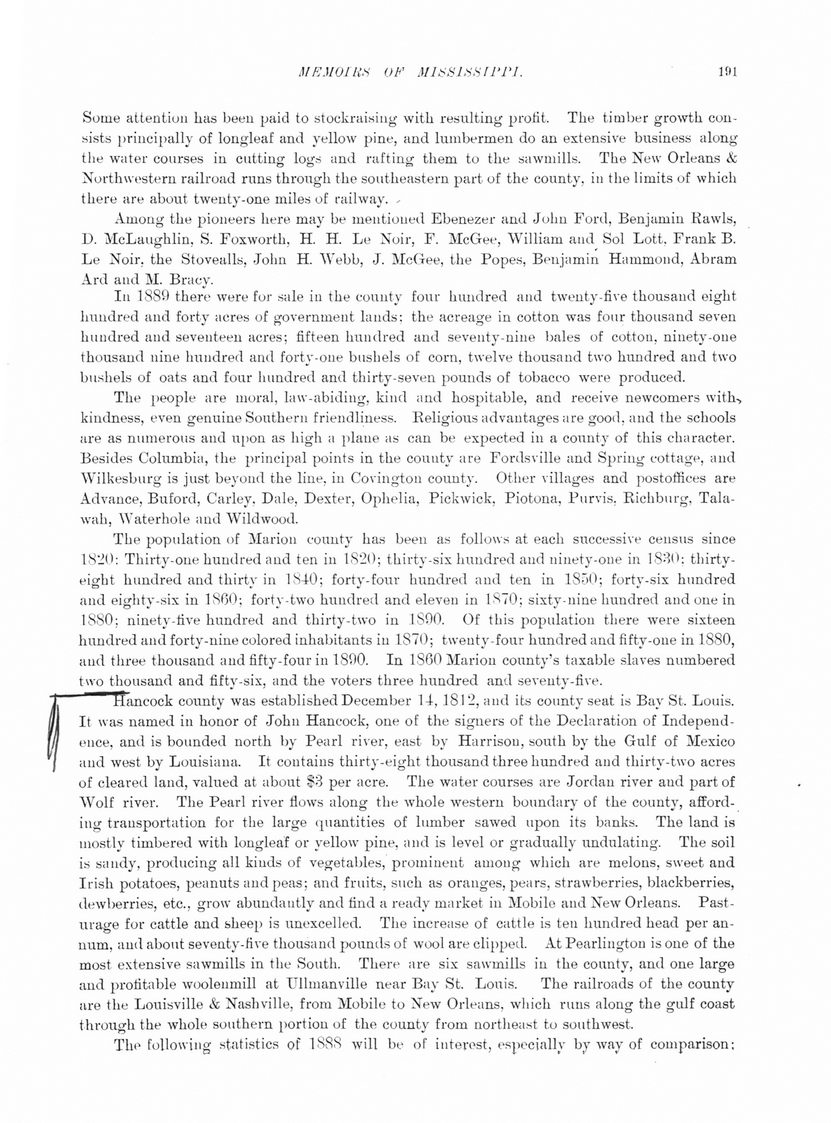This text was obtained via automated optical character recognition.
It has not been edited and may therefore contain several errors.
MEMOIRS OF MISSISSIPPI. 101 Some attention has been paid to stockraising with resulting profit. The timber growth consists principally of longleaf and yellow pine, and lumbermen do an extensive business along the water courses in cutting logs and rafting them to the sawmills. The New Orleans & Northwestern railroad runs through the southeastern part of the county, in the limits of which there are about twenty-one miles of railway. - Among the pioneers here may be mentioned Ebenezer and John Ford, Benjamin Rawls, D. McLaughlin, S. Foxworth, H. H. Le Noir, F. McGee, William and Sol Lott. Frank B. Le Noir. the Stovealls, John H. Webb, J. McGee, the Popes, Benjamin Hammond, Abram Ard and M. Bracy. In 1889 there were for sale in the county four hundred and twenty-five thousand eight hundred and forty acres of government lands: the acreage in cotton was four thousand seven hundred and seventeen acres; fifteen hundred and seventy-nine bales of cotton, ninety-one thousand nine hundred and forty-one bushels of corn, twelve thousand two hundred and two bushels of oats and four hundred and thirty-seven pounds of tobacco were produced. The people are moral, law-abiding, kind and hospitable, and receive newcomers with, kindness, even genuine Southern friendliness. Keligious advantages are good, and the schools are as numerous and upon as high a plane as can be expected in a county of this character. Besides Columbia, the principal points in the couuty are Fordsville and Spring cottage, and Wilkesburg is just beyond the line, in Covington county. Other villages and postoffices are Advance, Buford, Carley, Dale, Dexter, Ophelia, Pickwick, Piotona, Purvis. Richburg, Tala-wali, Waterhole and Wildwood. The population of Marion county has been as follows at each successive census since 1820: Thirty-one hundred and ten in 1820; thirty-six hundred and ninety-one in 1830: thirty-eight hundred and thirty in 1840; forty-four hundred and ten in 1850; forty-six hundred and eighty-six in 1860; forty-two hundred and eleven in 1870; sixty-nine hundred and one in 1S80; ninety-five hundred and thirty-two in 1S90. Of this population there were sixteen hundred and forty-nine colored inhabitants in 1870; twenty-four hundred and fifty-one in 1880, and three thousand and fifty-four in 1890. In 1S60 Marion county’s taxable slaves numbered two thousand and fifty-six, and the voters three hundred and seventy-five. Hancock county was established December 14, 1812, and its county seat is Bay St. Louis. It was named in honor of John Hancock, one of the signers of the Declaration of Independence, and is bounded north by Pearl river, east by Harrison, south by the Gulf of Mexico and west by Louisiana. It contains thirty-eight thousand three hundred and thirty-two acres of cleared land, valued at about S3 per acre. The water courses are Jordan river and part of Wolf river. The Pearl river Hows along the whole western boundary of the county, affording transportation for the large quantities of lumber sawed upon its banks. The land is mostly timbered with longleaf or yellow pine, and is level or gradually undulating. The soil is sandy, producing all kinds of vegetables, prominent among which are melons, sweet and Irish potatoes, peanuts and peas; and fruits, such as oranges, pears, strawberries, blackberries, dewberries, etc., grow abundantly and find a ready market in Mobile and New Orleans. Pasturage for cattle and sheep is unexcelled. The increase of cattle is ten hundred head per annum, and about seventy-five thousand pounds of wool are clipped. At Pearlington is one of the most extensive sawmills in the South. There are six sawmills in the county, and one large and profitable woolenmill at Ullmanville near Bay St. Louis. The railroads of the county are the Louisville & Nashville, from Mobile to New Orleans, which runs along the gulf coast through the whole southern portion of the county from northeast to southwest. The following statistics of 18SS will be of interest, especially by way of comparison:

Hancock County 1 Memoirs-of-Mississippi-excerpt-(002)